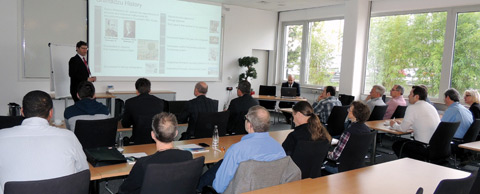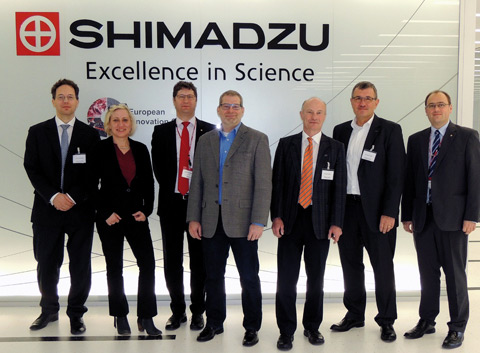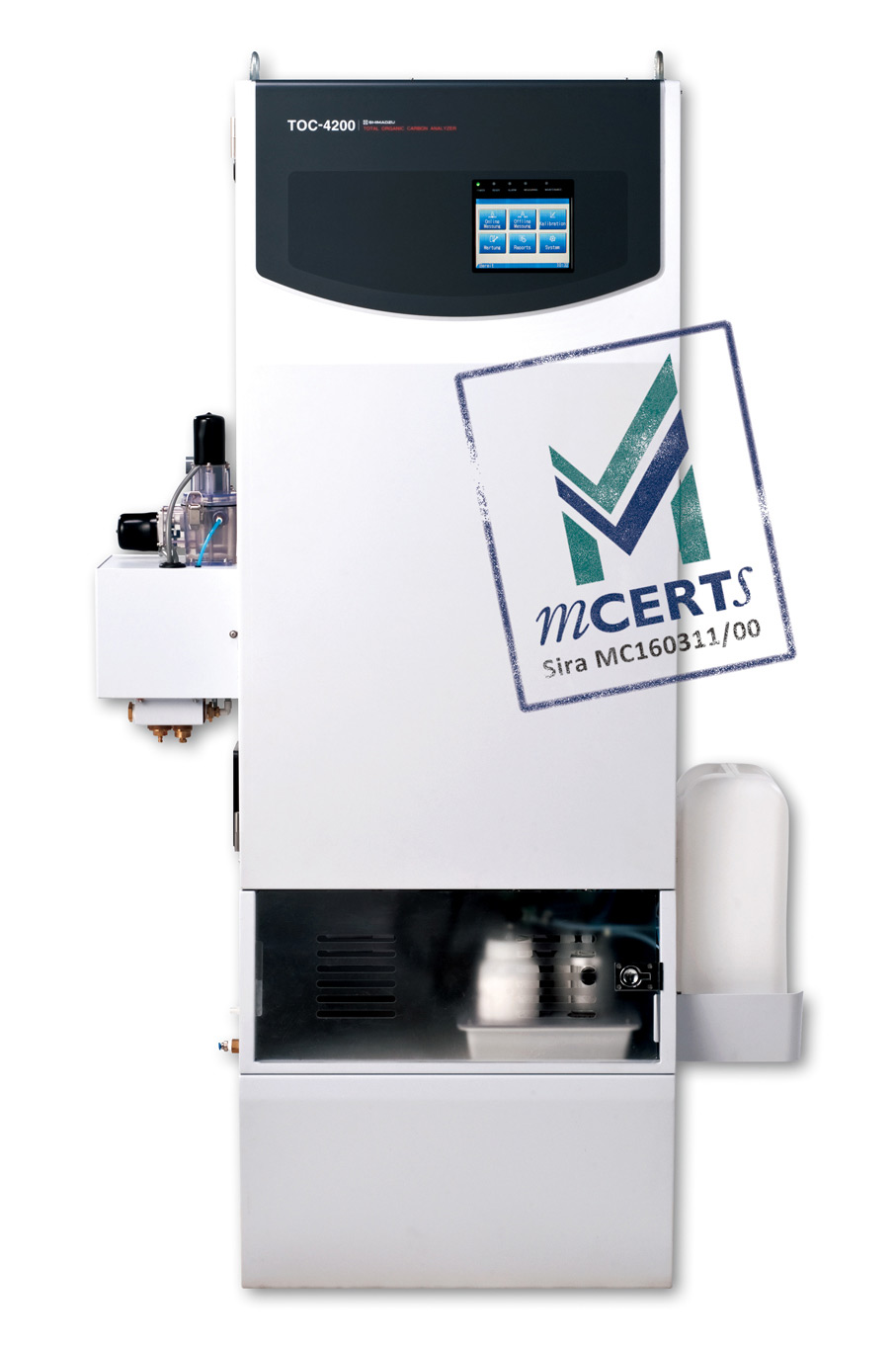Current state of process analysis technology
2nd TOC Process Analysis day in Duisburg features lectures and discussions between experts
In mid-March 2017, Shimadzu hosted the TOC Process Analysis day for the second time. Users, planners and engineers from industry and academia met to discuss the current state of process analysis technology.
TOC (Total Organic Carbon) determination is of great importance in many industries. The TOC sum parameter specifies the total content of organic carbon in a single analytical measurement value. TOC determination can be carried out safely and simply in the laboratory as well as during online process analysis. With its TOC-4200 series, Shimadzu currently offers online TOC systems for continuous process analysis.
Two years ago, Shimadzu organized the TOC Process Analysis day for the first time as a platform for sharing experiences and networking for users of process analysis technologies. It now takes place in alternate years with the TOC User Meeting that has meanwhile existed for 15 years. Just like the first TOC Process Analysis day in 2015, speakers from industry and academia presented application-related lectures and shared their experiences with participants.
 Figure 1: Lively discussions and interesting lectures at the second TOC Process Analysis day in Duisburg, Germany
Figure 1: Lively discussions and interesting lectures at the second TOC Process Analysis day in Duisburg, Germany
Monitoring purified water
In many applications, the TOC parameter is a measure of undesirable contaminations. Monitoring of water quality is especially important when using purified water. Dr. Raoul Schröder (Bürkert Werke, Germany) showed that the use of peripheral equipment also influences water quality.
Bürkert, manufacturer of valves and valve technologies, investigates the influence on water pollution caused by components of fluid plants. When flowing through a fluid plant water comes into contact with various types of equipment such as pumps, pipes or valves. This can lead to mobilization of different compounds from these components, which contaminate the water. The magnitude of these contaminations may only be in the lower ppm range but these contaminations become important when using ultrapure water and most certainly in regard to quality assurance for manufacturers of water-bearing components.
Higher quality requires higher data density
Demands on modern production processes are steadily increasing. Not only is there a growing demand to cut costs as well as to save energy and raw materials, but production capacity, efficiency and flexibility should also be increased. And all this with ever higher quality requirements.
“In order to meet these demands, it is necessary to generate higher data density for automated process control”, says Andreas Gräfe of Lanxess Germany, when discussing the general benefits of process analysis technology (PAT).
The use of laboratory analysis is more and more taking a backseat. Nowadays, hardly any large-scale plant is started up without having to supply corresponding process analysis data for process control. The demands placed on the systems used are based primarily on achieving the highest possible availability as well as on increasing data density. In this way, PAT is of benefit to plant and process safety and also to employee and environmental protection.
 Figure 2: Seminar speakers (from left to right): Dr. Raoul Schröder (Bürkert Werke GmbH & Co. KG), Bettina Gierszewski (Shimadzu Europa GmbH), Mischa Dings (Shimadzu Deutschland GmbH), Ralf Kienle (Clariant Plastics & Coatings Deutschland GmbH), Dr. Tomas Sauter (Covestro Deutschland AG), Andreas Gräfe (Lanxess Deutschland GmbH) and Sascha Hupach (Shimadzu Deutschland GmbH).
Figure 2: Seminar speakers (from left to right): Dr. Raoul Schröder (Bürkert Werke GmbH & Co. KG), Bettina Gierszewski (Shimadzu Europa GmbH), Mischa Dings (Shimadzu Deutschland GmbH), Ralf Kienle (Clariant Plastics & Coatings Deutschland GmbH), Dr. Tomas Sauter (Covestro Deutschland AG), Andreas Gräfe (Lanxess Deutschland GmbH) and Sascha Hupach (Shimadzu Deutschland GmbH).
TOC data density allows for more precise process control
Modern online measuring systems technology features availability of 99 % or higher and thus offers the required reliability for automated process control. Andreas Gräfe illustrated this with a practical example: Prior to the use of process technology, wastewater monitoring had been carried out by appropriate laboratory analyses.
A TOC analysis took approximately 40 minutes including sampling and sample transfer to the laboratory. By using Online-TOC, analysis results are delivered automatically in ten minute intervals. Because of the increased amount of data, the wastewater is more closely monitored. The company thus obtains more information on its wastewater and can control its production process more precisely. Cleaning costs incurred in the wastewater treatment plant can now be more efficiently allocated (in accordance with the ‘polluter pays principle’). Based on the higher data density, reporting to the authorities is also more precise.
MCERTS certified performance and reliability standard
In order to verify the high availability of process analyzers, the Environmental Agency of England and Wales (UK) has developed a certification system for measurement equipment – the MCERTS accreditation. It provides the framework conditions and quality objectives for companies to meet in order to comply with authority requirements for environmental monitoring. MCERTS is quickly becoming a required performance and reliability standard by organizations around the world. With accredited equipment, companies and authorities ensure that they are doing everything possible to protect their environment.
Requirements for obtaining MCERTS certification include various laboratory tests and a 3-month field test under real conditions. Measurements are performed by an independent testing facility according to predefined testing methods. MCERTS accreditation has been issued to measurement systems in Shimadzu’s TOC-4200 series. TOC product manager Bettina Gierszewski at Shimadzu, in her presentation on MCERTS, discussed the test measurements performed as well as the results of the TOC-4200 field test.
 Figure 3: Shimadzu TOC-4200 with MCERTS accreditation
Figure 3: Shimadzu TOC-4200 with MCERTS accreditation
TOC content of waste-water a decisive criterion for disposal
Ralf Kienle, Clariant Plastics & Coatings Germany, reported on the use of laboratory and online measurements for monitoring of industrial wastewater effluents. The pigment production process generates wastewater during various purification stages, which is discharged at regular intervals into the wastewater treatment plant of the Hoechst Chemical Park, Germany.
TOC content of the wastewater is considered as a decisive criterion for disposal. Until recently TOC analysis was performed reliably using a laboratory system. The use of an online measuring system now saves time. In addition, by connecting the analyzer to the process control system, untimely discharge of wastewater due to human error can be prevented. During the analysis, the process control system automatically locks all pumps.
Planning stages and project management for process analysis
The final speaker on the 2nd TOC Process Analysis day was Dr. Thomas Sauter of Covestro Germany. He presented an interesting insight into the various planning stages and project management for process analysis in investment projects. He showed the tried and tested project phases for the construction of ‘plug and play’ analysis containers. These were designed, built and transported to their places of destination, for example a chemical factory in China, by Covestro PAT specialists. Thomas Sauter pointed out what needs to be taken into consideration and how many different contacts are involved as well as specialist departments that need to be included.
Read for you in LABO Mai 2017